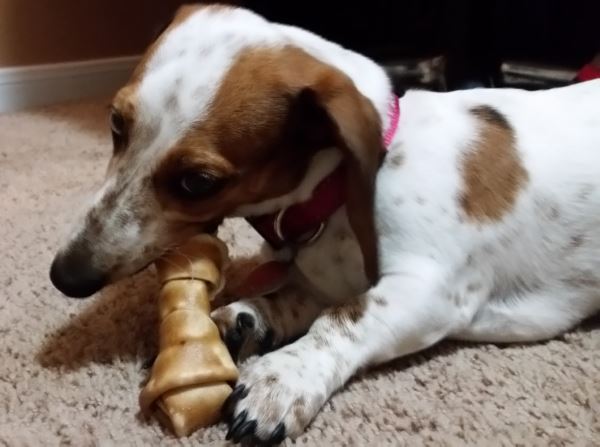
Dachshunds love to chew. I mean, really love to chew.
And if they’re puppies, anything is fair game in their book. Shoes. Socks. Plastic water bottles. The mail. Other dachshunds. Your hand. The leg of the rocking chair. Pillows. Bed sheets. Should I go on? Because I can. You probably can too if you have had your doxie since puppyhood.
And rawhide chews can provide a great alternative to the book that’s on your nightstand.
But are they safe?
You hear so many horror stories of dogs that have had serious problems related to rawhide bones. Because my doxies absolutely love them, I wanted to see if there was anything to worry about.
So, I did a ton of research. Maybe even two tons. I even conducted an experiment. Here’s what I found…
The first thing I wanted to know was…
Why do dachshunds (and other dogs) like to chew rawhide and are there any benefits?
Well, it turns out there are numerous reasons, and numerous benefits.
Chewing is a natural instinct for your dog.
It’s just one way, of many, that dogs explore and gather information about their environment. By chewing something, such as a stick or rawhide, dogs learn something about it – like, if its food, or something else that might be beneficial. By the way, the leg of a wooden chair is a just another piece of wood to your dog until taught that indoor wood is different from outside wood (a.k.a. sticks), and that chewing outside wood doesn’t result in a scolding. Pretty confusing when you think about it that way.
Puppies chew a lot because they are teething.
Teething starts when a puppy is around 2 or 3 months old, and continues until their baby teeth fall out and are replaced by their adult teeth. The transition to adult teeth is typically complete around 8 months of age, to as long as a year. So puppies instinctively chew to aid in the process of shedding their baby teeth to make way for their adult teeth. It also helps relieve tenderness of any new teeth cutting through their gums.
Chewing exercises their jaw muscles and keeps them strong.
This too is instinctual. Our little doxies are domesticated and might be [begin sarcasm] just a tad bit pampered [end sarcasm], but their ancestors depended on strong jaws for hunting and for protecting themselves, or the pack. This instinct is still there in our weens.
Chewing provides comfort.
Chewing rawhide, or just chewing in general, helps relieve anxiety and provides comfort. Sometimes just having something in their mouth gives them a sense of security. Does your dox look for a toy before they go outside? Mine do. If there’s a toy or bone around by the back door, it’s going out with them.
Chewing rawhide cleans teeth.
As the rawhide is being chewed, the dog’s saliva will soften it, allowing it to wrap around and squeeze in between the teeth, rubbing off plaque in the process. In short (Did you catch that? Short. Like a dachshund), rawhide chews help doxies keep there teeth clean and aids in fresher smelling breath.Having clean teeth is very important to your ween’s good health. Poor dental hygiene can allow bad bacteria to grow and enter into there bodies, causing issues such as kidney or heart disease.
Keeps them occupied.
Dogs get bored too. That’s when they get into something they shouldn’t. Chewing rawhide bones gives them something to do and helps keep them out of trouble. Trouble like digging through the trash, shredding toys, shredding tissue, or shredding sofa pillows.
Its fun.
Dachshunds just love to chew. They just enjoy the taste of rawhide and they have a good ol’ time chewing it. Some will literally spend hours chewing if you allow them.
It re-directs their chewing instinct.
So we have established, dachshunds are going to chew something. So, we give them rawhide chews, in addition to the reasons above, to re-direct their chewing instincts to minimize destruction of stuff. Our human stuff.
Now we know the benefits and why’s of chewing rawhide. But before we get into the risks, we need to understand what it is first.
What exactly is rawhide?
What most people think, myself previously included, is that rawhide chews are a product of the beef industry. After all, its made from the hide of a cow, right? Well yes, that’s true, however, they are actually considered a by-product of the leather industry.
The hides are sent to tanneries and leather factories where the outer layer is separated from the inner layer. The outer layer is processed into leather for goods, such as belts, shoes, clothes, leather sofas, and so on. It’s the softer inner layer that is used for rawhide chews, among other non-doxie related products.
So, on to the risks…
The dangers of chewing rawhide.
The risks of chewing rawhide mostly come from three mechanisms.
Contamination.
Two types of contamination to be concerned about. Bacterial, such as E. Coli or Salmonella, and from trace amounts of toxic chemicals left over from the manufacturing process.
Remember when we found out that rawhide chews are a product of the leather industry? Well, here’s the problem. Because of reasons we won’t get into here, factories and manufacturing plants have been leaving the the United States like doxies running away from the back door on a rainy day. Since rawhide chews are made at leather factories, that means most are made outside of the U.S.A..
The U.S. produces, and consumes, a lot of beef and beef products. And the quality is considered very good. So even though the majority of rawhide is processed outside of the United States, the beef hide being used for rawhide chews is usually exported from the United States for processing, then imported back in the U.S. as a finished rawhide chew product.
Since beef hide is a perishable product, it must have preservatives, meaning chemicals, added to it to keep it from spoiling while it is being shipped. The longer it is in transit, the more preservatives must be added. China is one of the largest exporters of beef hide, so as you can imagine, it could be in transit for a long period of time.
Even with preservatives added, decomposition and pathogenic bacterial growth can occur. So, in short (like a ween – hehe), the two sources of contamination are either coming as a result of pathogenic bacteria growth from the decomposition of the hide, or from the addition of toxic preservatives in an attempt to control or sanitize the fore-mentioned pathogenic bacterial growth. While the preservatives and sanitizing chemicals should be cleansed away, that does not always occur.
Digestive irritation.
Contaminated rawhide can most certainly cause digestive irritation, but assuming there is no contamination, some dogs just have a sensitivity to the coloring or flavoring that may have been added, or possibly to the rawhide itself. While digestive irritation is usually not a life threatening situation, it’s no walk in the dog park either and may cause discomfort or diarrhea.
Choking or intestinal blockages.
Here’s the risk I’ve often heard about over and over, and what started my in-depth research into rawhide chews. The danger of choking, intestinal blockage, or even perforation of the intestines.
As we know, dogs will chew on just about anything, and sometimes they swallow it. Anytime a dog swallows something too large, it can get stuck in the esophagus or cause a blockage in the intestines, which can be very dangerous. Even life threatening. It may even require emergency surgery in the worst cases.
Then there is the danger of thin, sharp pieces of rawhide being swallowed whole before they have had a chance to soften up from chewing, causing a tear in the esophagus, stomach, or intestines. This too can be very serious and require surgical intervention.
So, there you have the dangers, but the thing is…
In a little over 20 years of wiener dog ownership, I have never had a problem with the weens eating rawhide chews. And believe me, I have bought enough rawhide chews in that time to fund a nice trip to just about anywhere.
I have also never heard a first hand story of anyone else having issues with rawhide chews.
I have heard first hand of a dog that had an intestinal blockage from swallowing a sock and as a result had to undergo surgery. And a distant relative who lost their dog to a perforated intestine, not from a rawhide chew, but from a product that was proudly marketed as a rawhide substitute made from processed vegetables with a chicken wafer on the inside.
So what’s the deal?
I know issues can occur with rawhide. And there are a lot of articles out there that essentially proclaim that you are either evil or a few-dachshunds-short-of-a-dozen if you give your dog rawhide chews, and that it’s just a matter of time before you have a problem.
But just how common are issues related to chewing rawhide? After all, driving a car is a risk, but it doesn’t stop us from driving. But on the other hand, I wouldn’t go golfing in the middle of a thunderstorm either.
So are they safe or not?
Well, here’s my take after the 2-tons of research that I did. Sure there’s risk, but there is a risk for just about anything you do. The question you have to ask yourself is…
Do the benefits outweigh those risks?
This is something you have to answer for yourself, on behalf of your dog. But for me, the answer is… Yes.
Let me explain why.
The benefits are numerous, no doubt about that.
I believe the risks are very very small.
There are steps you can take to minimize risks even further.
The benefits are numerous.
Just refer back to the why dogs chew section above – lots of benefits. And I can attest to the teeth cleaning thing. Let me tell you the story of Lucy, Petey, and Daisy. Those are my 3 doxies. Petey and Daisy will chew rawhide for hours, and their teeth are impressively white with no tartar build up. Lucy does not like to chew so much – not sure why, that’s just Lucy. But guess what. Lucy gets tartar build up on her teeth.
The risks are small.
Based on my research, when compared to the amount of rawhide bones that are being consumed, there are very few issues that come from true rawhide chews. The rawhide substitutes that are made to look like rawhide, but are said to be safer – that may be a different story.
The problem with the many articles that howl about the evils of rawhide – well, they just don’t supply the facts to back up their claims. Not to say that rawhide problems don’t occur, because I’m sure they do. Problems also occur with food, socks, toys, balls, coins, sticks, chicken bones, and many more numerous items that dogs get their paws on. Again, based on my research, issues coming rawhide bones are very rare.
My pro-rawhide stance was really solidified when I read a comment from an article on The Bark. The comment was from a person who was searching for a rawhide alternative because they also heard of the dangers of rawhide. So when she asked a well-respected veterinarian of 40 years about what he gives his dogs to chew, he said he gives them rawhide, and that “in his forty years of practicing, he has never had a problem case due to rawhides.” So in 40 years of giving his own dogs rawhide chews, and 40 years of veterinary practice, the vet’s personal dogs, and all the dogs under his care never had a single problem.
On to the Experiment…
Remember the experiment I said I conducted? One of the dangers of rawhide that you frequently hear is when a dog swallows a piece of rawhide, that it could expand in the intestines from moisture and cause a blockage. So I tested that.
I soaked a piece of rawhide in a container full of water for approximately 8 hours to see if it would expand. See the results for yourself below…
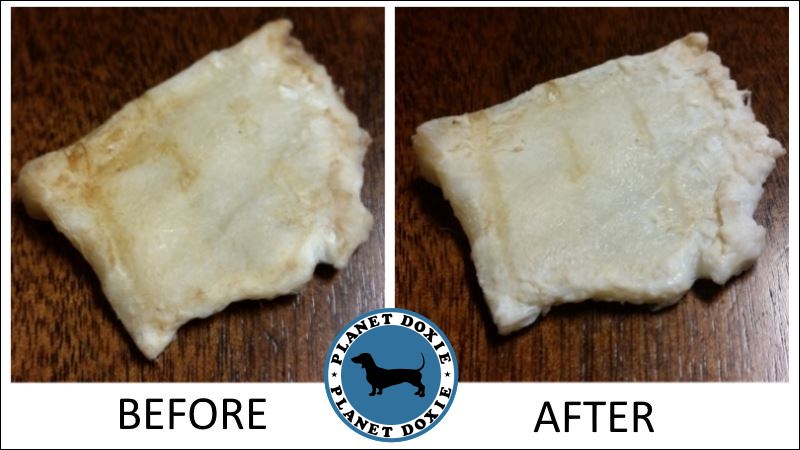
No significant expansion. Plus the rawhide piece I used was 100% dry. Typically the rawhide is moistened and softened by the dogs saliva and any expansion that is going to occur has already happened prior to swallowing.
Things you can do to make rawhide chewing even safer.
It is my opinion that rawhide is pretty safe, again, based on my 2-tons of research and personal experience – but there are a few things you can do to make it even safer for your dox to chew.
Supervise.
It even says this on the package. Don’t let your dog chew unsupervised. When you’re not around, pick it up.
Throw it away when it gets too small.
When the rawhide chew gets too small, just throw it away. This is removing the choking and blockage hazard altogether. Generally, it needs to be bigger than your dog’s mouth. If the whole thing fits in your dogs mouth, throw it away. If your not sure about the size, it’s better just to throw it out.
There is an art to this, however. Offer a treat as an exchange for the small piece of rawhide. Dogs have a tendency to wolf it down once they learn that you’re about to take it away.
Buy only high quality thick chews.
Thin rawhide can be easily broken off before it has had a chance to soften from chewing, causing a higher risk of swallowing small sharp pieces that can cause internal damage.
Buy only high quality chews made from a single piece of rawhide.
Even the popular knotted rawhide bones should be made from a single piece of folded rawhide. If the knots are separate pieces, they can easily be pulled off causing an increased hazard of swallowing a large piece. Watch for the chews that have small pieces stuffed inside the rolls as filler.
Buy chews made in the U.S.A.
For two reasons. First, because there is a shorter ship time from farm to factory, meaning less time for decay, and less preservatives needed. Second, because there are stricter production controls against using highly toxic chemicals than there are in other countries. Watch for packages that say ‘Made in America’ versus ‘Made in the U.S.A’ because they might be made in South America, which is technically made in America. If you live outside the U.S.A., I would look for something organic and made locally as possible.
Buy organic.
If you can find it, buy organic.
Conclusion and Doxie Disclaimer
So there you have it. And let me say again, this is my opinion and is intended for informational purposes. Ultimately, you have to decide what’s right concerning rawhide chews for yourself and your little bud, and if the risk is acceptable. Also, I encourage you to do your own research.
Also, look for future updates as I research possible rawhide chew alternatives, and possibly a recommendation on particular brands.

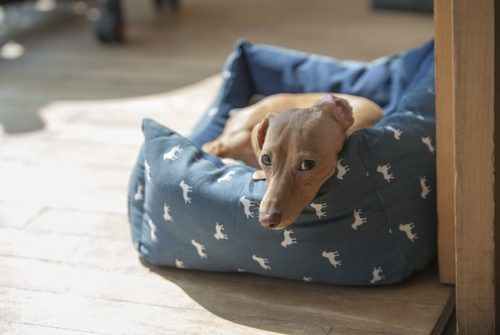
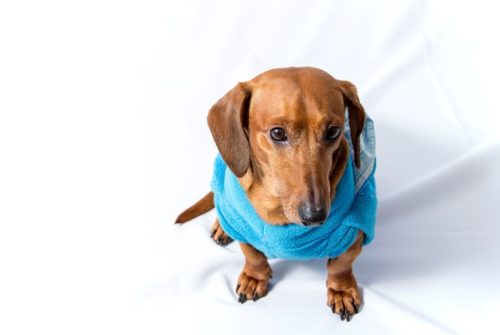

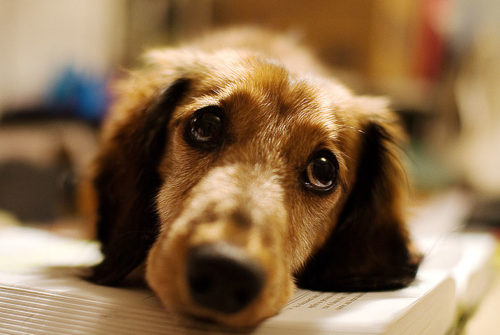

Thank you for this important information. My mini red (Dewey) and tweenie piebald (Levi) love rawhide. I’ve avoided buying it because Levi is an aggressive eater, and I’ve been afraid that he may gulp a piece that is too large and choke. I’ll try again with your recommendations. What is your opinion of piggy ears?
Hi Lisa,
Not sure about the pig ears. I’ve never researched or given any to my doxies. Bully Sticks are great, but they are so expensive.
If Levi is an aggressive eater, I would definitely watch him while he chews and discard the rawhide before it gets to the size where he can swallow it. My hounds know when I’m about to take it away and tend to want to wolf it down, so I offer a piece of ham or some peanut butter (which they can’t resist), then take the rawhide away when go for the treat.